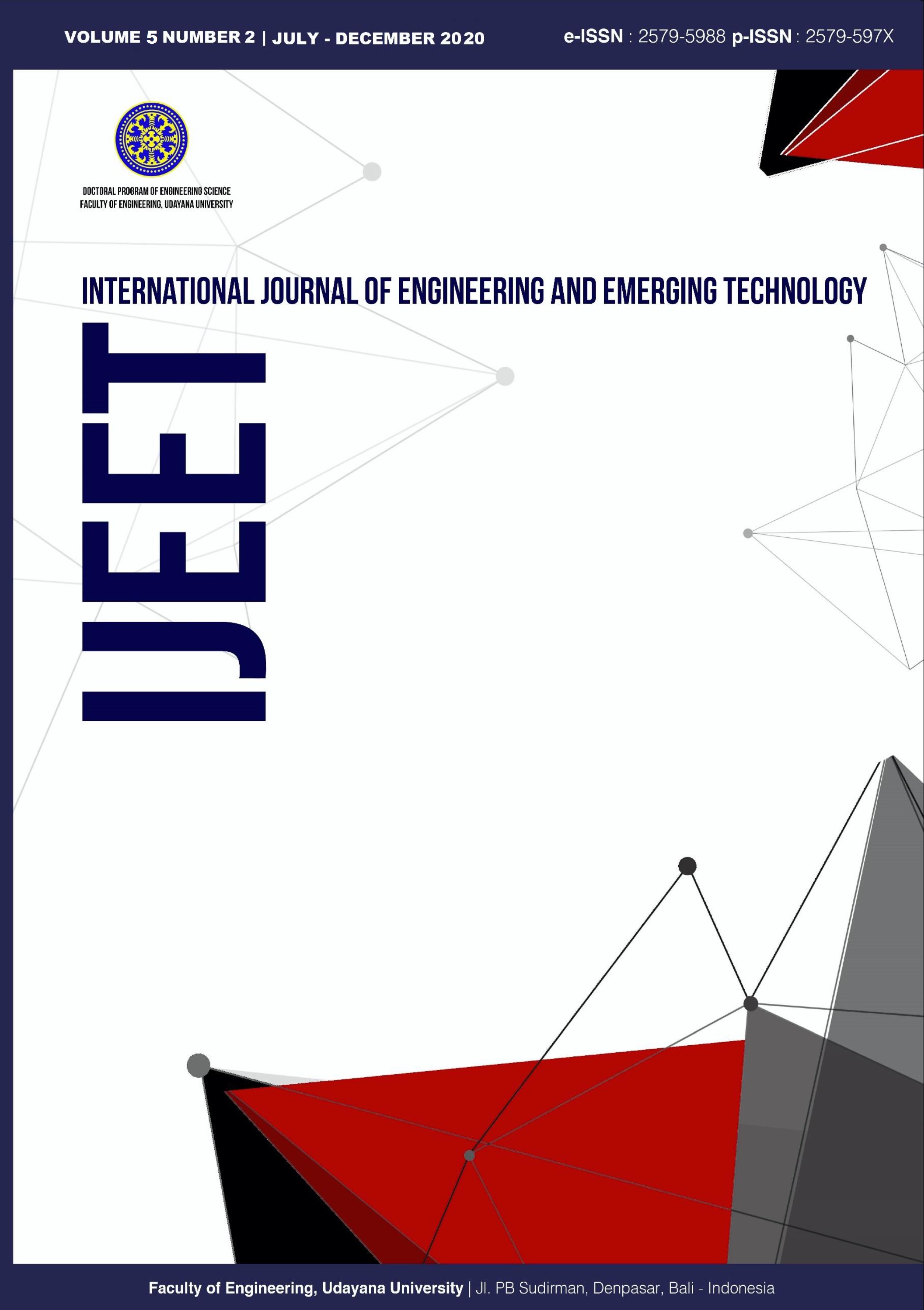Thermal Conductivity and Bending Strength of Coconut Fiber/Paraffin/Graphite Composite Phase Change Materials
Abstract
The use of composite materials for panel boards, building construction, vehicle accessories, and household furniture is growing. Coconut coir fiber-reinforced composites can be applied as panel boards for building and furniture construction, which can also be used as heat storage systems. The coco fiber composite's low energy storage capacity can be increased by incorporating PCM material into it, forming a PCM composite material. Heat absorption and release performance depend on the material's thermal conductivity, which can be increased by adding additives such as graphite. This paper presents a performance test of PCM composites to obtain bending strength and thermal conductivity. The research materials were coconut coir fiber, polyester, paraffin, and graphite. The weight fractions of coco fiber and polyester were 30 and 50%, respectively. Variation of paraffin weight fraction 15 and 20% and variation of graphite weight 0 and 5%. The method of mixing materials is direct incorporation and forming of PCM composites using a press molding process. The tests carried out include the bending test (ASTM D790-03) and the thermal conductivity test using the Heat Transfer Experiment Base Unit test kit. The results show that the use of 15 wt% paraffin with 5 wt% graphite increases thermal conductivity by 23.27% and increases bending strength by 36.71%.
Downloads
References
[2] Jones, R.M., Mechanics of composite materials. 1998: CRC press.
[3] U Abass, R., F. U Abass, and M. O Abas, Improvement of Mechanical Properties of Polyester Composite Reinforced By Bio Filler (Acro Shell). 2015.
[4] Gibson, R.F., Principles of composite material mechanics. 2016: CRC press.
[5] Astika, I., I. Lokantara, and I. Karohika, Sifat Mekanis Komposit Polyester dengan Penguat Serat Sabut Kelapa. Jurnal Energi dan Manufaktur, 2013. 6(2): p. 95-202.
[6] ASTM, S., Standard test methods for flexural properties of unreinforced and reinforced plastics and electrical insulating materials. ASTM D790. Annual book of ASTM Standards, 1997.
[7] Sarı, A., A. Karaipekli, and C. Alkan, Preparation, characterization and thermal properties of lauric acid/expanded perlite as novel form-stable composite phase change material. Chemical Engineering Journal, 2009. 155(3): p. 899-904.
[8] Khedache, S., et al., Preparation and thermal characterization of composite “Paraffin/Red Brick” as a novel form-stable of phase change material for thermal energy storage. International Journal of Hydrogen Energy, 2015. 40(39): p. 13771-13776.
[9] Li, X., J.G. Sanjayan, and J.L. Wilson, Fabrication and stability of form-stable diatomite/paraffin phase change material composites. Energy and Buildings, 2014. 76: p. 284-294.
[10] Memon, S.A., Phase change materials integrated in building walls: A state of the art review. Renewable and sustainable energy reviews, 2014. 31: p. 870-906.
[11] Cui, Y., et al., A review on phase change material application in building. Advances in Mechanical Engineering, 2017. 9(6): p. 1687814017700828.
[12] Astika, I., et al., Phase Change Materials for Building Applications: A Review. Proceeding SNTTM XVIII, 2019: p. 1-10.
[13] Zwanzig, S.D., Y. Lian, and E.G. Brehob, Numerical simulation of phase change material composite wallboard in a multi-layered building envelope. Energy Conversion and Management, 2013. 69: p. 27-40.
[14] Chhugani, B., et al., Energetic performance of two different PCM wallboards and their regeneration behavior in office rooms. Energy Procedia, 2017. 122: p. 625-630.
[15] Zhou, S., et al., Modification of expanded graphite and its adsorption for hydrated salt to prepare composite PCMs. Applied Thermal Engineering, 2018. 133: p. 446-451.
[16] Zhang, Y., et al., Evaluation of paraffin infiltrated in various porous silica matrices as shape-stabilized phase change materials for thermal energy storage. Energy Conversion and Management, 2018. 171: p. 361-370.
[17] Huang, X., et al., Thermal properties and applications of microencapsulated PCM for thermal energy storage: A review. Applied Thermal Engineering, 2019. 147: p. 841-855.
[18] Gondora, W., et al., Encapsulation of phase change materials using rice-husk-char. Applied energy, 2016. 182: p. 274-281.
[19] Jamekhorshid, A., et al., Composite of wood-plastic and micro-encapsulated phase change material (MEPCM) used for thermal energy storage. Applied Thermal Engineering, 2017. 112: p. 82-88.
[20] Rathore, P.K.S. and S.K. Shukla, Potential of macroencapsulated pcm for thermal energy storage in buildings: A comprehensive review. Construction and Building Materials, 2019. 225: p. 723-744.
[21] Asadi, I., et al., Thermal conductivity of concrete–A review. Journal of Building Engineering, 2018. 20: p. 81-93.
[22] Lin, Y., et al., Review on thermal conductivity enhancement, thermal properties and applications of phase change materials in thermal energy storage. Renewable and sustainable energy reviews, 2018. 82: p. 2730-2742.
[23] Jebasingh, B.E. and A.V. Arasu, A comprehensive review on latent heat and thermal conductivity of nanoparticle dispersed phase change material for low-temperature applications. Energy Storage Materials, 2020. 24: p. 52-74.
[24] Yuan, K., et al., A polymer-coated calcium chloride hexahydrate/expanded graphite composite phase change material with enhanced thermal reliability and good applicability. Composites Science and Technology, 2018. 156: p. 78-86.
[25] Zhang, P., et al., Experimental and numerical study of heat transfer characteristics of a paraffin/metal foam composite PCM. Energy Procedia, 2015. 75: p. 3091-3097.
[26] Rezaie, A.B. and M. Montazer, One-step fabrication of fatty acids/nano copper/polyester shape-stable composite phase change material for thermal energy management and storage. Applied Energy, 2018. 228: p. 1911-1920.
[27] Ramakrishnan, S., et al., A novel paraffin/expanded perlite composite phase change material for prevention of PCM leakage in cementitious composites. Applied Energy, 2015. 157: p. 85-94.
[28] Li, M., A nano-graphite/paraffin phase change material with high thermal conductivity. Applied energy, 2013. 106: p. 25-30.
[29] Liu, X. and Z. Rao, Experimental study on the thermal performance of graphene and exfoliated graphite sheet for thermal energy storage phase change material. Thermochimica acta, 2017. 647: p. 15-21.
[30] Kastiukas, G., X. Zhou, and J. Castro-Gomes, Development and optimisation of phase change material-impregnated lightweight aggregates for geopolymer composites made from aluminosilicate rich mud and milled glass powder. Construction and Building Materials, 2016. 110: p. 201-210.
[31] Memon, S.A., et al., Utilization of macro encapsulated phase change materials for the development of thermal energy storage and structural lightweight aggregate concrete. Applied Energy, 2015. 139: p. 43-55.

 Indexed By
Indexed By







